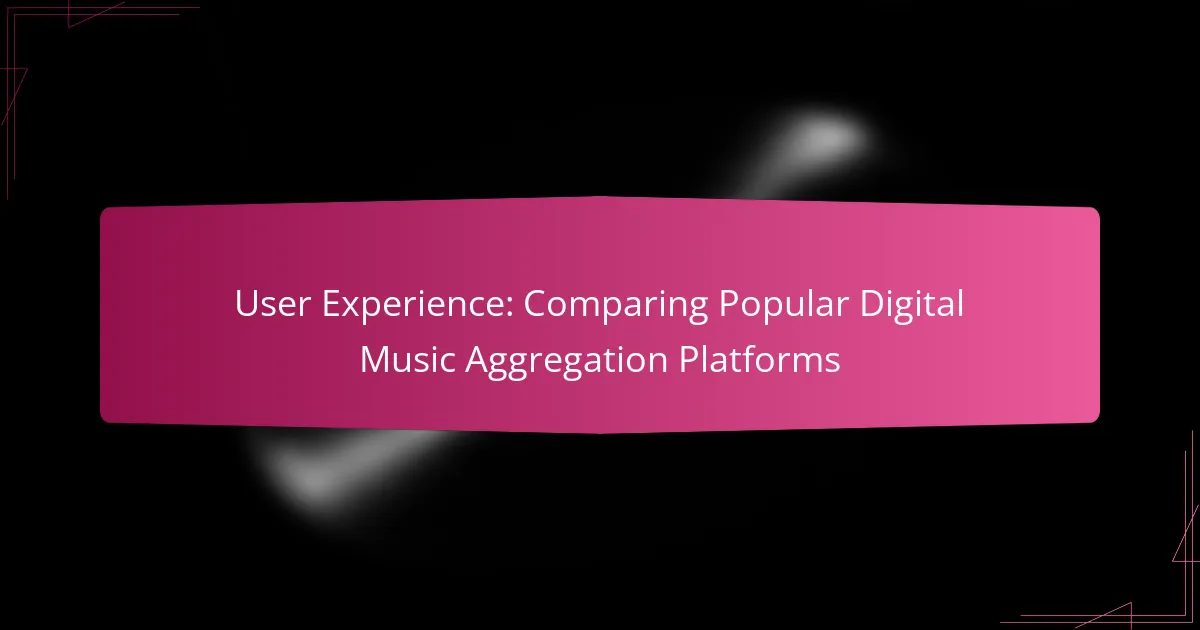In the ever-evolving landscape of digital music, artists rely on aggregation platforms like Spotify for Artists, Apple Music for Artists, SoundCloud, DistroKid, and TuneCore to distribute their work. Each platform presents distinct features and user experiences that cater to varying needs, influencing how effectively musicians can reach their audience. By examining factors such as interface design, customer support, and pricing models, artists can make informed decisions about which platform best aligns with their goals and budget.

Which digital music aggregation platforms are the most popular?
The most popular digital music aggregation platforms include Spotify for Artists, Apple Music for Artists, SoundCloud, DistroKid, and TuneCore. Each platform offers unique features and benefits that cater to different types of musicians and their distribution needs.
Spotify for Artists
Spotify for Artists allows musicians to manage their profiles, track performance metrics, and engage with fans. Artists can access detailed analytics about their streams, audience demographics, and playlist placements, which can inform marketing strategies.
One key feature is the ability to submit music for playlist consideration, which can significantly boost visibility. Artists should regularly update their profiles and utilize Spotify’s promotional tools to maximize reach and engagement.
Apple Music for Artists
Apple Music for Artists provides insights into how music is performing on Apple Music, including data on streams, purchases, and listener demographics. This platform is particularly beneficial for artists who want to understand their audience on Apple’s ecosystem.
Utilizing the platform’s analytics can help artists tailor their promotional efforts. Artists should consider leveraging Apple Music’s curated playlists to enhance their exposure and reach a broader audience.
SoundCloud
SoundCloud is a platform that allows artists to upload and share their music directly with fans, making it a popular choice for independent musicians. It offers a community-driven approach, where listeners can comment on tracks and interact with creators.
SoundCloud also provides monetization options through its Pro and Premier plans, which can be advantageous for artists looking to earn revenue from their music. Engaging with the community and promoting tracks through social media can enhance an artist’s presence on this platform.
DistroKid
DistroKid is a digital distribution service that helps artists get their music onto major streaming platforms like Spotify, Apple Music, and more. It operates on a subscription model, allowing artists to upload unlimited tracks for a flat annual fee.
This platform is known for its speed in getting music released, often within a day. Artists should be aware of the terms regarding royalties and ensure they understand how to maximize their earnings through effective distribution strategies.
TuneCore
TuneCore offers digital distribution services similar to DistroKid but charges per release rather than a flat fee. This can be beneficial for artists who release music less frequently, as they only pay when they distribute new tracks.
TuneCore also provides tools for publishing and sync licensing, which can open additional revenue streams. Artists should carefully consider their release strategy and budget when choosing between TuneCore and other platforms.

How do these platforms compare in user experience?
The user experience across popular digital music aggregation platforms varies significantly, impacting how artists and labels distribute their music. Key factors include interface design, customer support, and analytics capabilities, all of which influence usability and satisfaction.
Interface design and usability
Interface design plays a crucial role in how easily users can navigate digital music aggregation platforms. A clean, intuitive layout allows artists to upload music, manage profiles, and track releases without confusion. For example, platforms like DistroKid and TuneCore offer straightforward dashboards that simplify these processes.
Usability also encompasses mobile compatibility. Many users prefer managing their accounts on mobile devices, so platforms that provide responsive designs or dedicated apps tend to enhance user experience. Look for platforms that prioritize user-friendly interfaces to minimize the learning curve.
Customer support options
Customer support is essential for resolving issues quickly and effectively. Most platforms offer a combination of email support, FAQs, and community forums. However, some, like CD Baby, provide more extensive support options, including live chat, which can be a significant advantage for users needing immediate assistance.
When choosing a platform, consider the availability of support during your working hours. If you operate primarily in a specific time zone, ensure the platform’s support aligns with your schedule to avoid delays in resolving issues.
Analytics and reporting features
Analytics and reporting features are vital for understanding audience engagement and sales performance. Platforms like Amuse and DistroKid provide detailed reports on streaming statistics, sales, and geographic performance, helping artists make informed decisions about marketing and future releases.
Look for platforms that offer real-time analytics and easy-to-read reports. This can help you track trends and adjust your strategies quickly. Additionally, consider whether the platform integrates with other tools you use for marketing or social media, as this can enhance your overall data analysis capabilities.

What are the pricing models for digital music aggregation platforms?
Digital music aggregation platforms typically use various pricing models, including subscription fees, revenue sharing, and free options. Understanding these models helps artists choose the best platform for their needs and budget.
Subscription fees for DistroKid
DistroKid operates on a subscription fee model, charging artists an annual fee to distribute their music across multiple streaming services. The standard fee is around $19.99 per year for unlimited uploads, making it a cost-effective option for musicians who release multiple tracks annually.
Artists should consider that DistroKid does not take a cut of their earnings, allowing them to keep 100% of their revenue. This model is particularly beneficial for those planning to release a steady stream of music.
Revenue share for TuneCore
TuneCore utilizes a revenue share model, where artists pay a fee to distribute their music and then keep 100% of their earnings. However, TuneCore charges an annual fee per release, which can range from about $9.99 for a single to $49.99 for an album.
This model can be advantageous for artists who expect to generate significant revenue from their music, as they retain all profits. However, the upfront costs can add up, especially for those with multiple releases.
Free options for SoundCloud
SoundCloud offers free options for artists to upload and share their music, making it accessible for newcomers. While the free tier has limitations, such as a cap on upload hours, it allows artists to build an audience without any financial commitment.
For those looking to monetize their music, SoundCloud also provides a Pro subscription that unlocks additional features and removes upload limits. Artists should weigh the benefits of starting free against the potential need for upgrades as their audience grows.

What features enhance user experience on these platforms?
Key features that enhance user experience on digital music aggregation platforms include distribution speed, social media integration, and royalty tracking tools. These elements significantly impact how artists engage with their audience and manage their music careers.
Distribution speed and reach
Distribution speed refers to how quickly music is made available on various streaming platforms after upload. Many popular services can distribute tracks within a few hours to a couple of days, allowing artists to reach listeners rapidly. Consider platforms that offer expedited distribution for time-sensitive releases, such as singles tied to promotional events.
Reach is equally important; some platforms distribute to hundreds of stores and streaming services globally, while others may have a more limited selection. Artists should evaluate the breadth of distribution options to ensure their music is accessible to their target audience.
Integration with social media
Effective integration with social media allows artists to promote their music seamlessly across platforms like Instagram, Facebook, and Twitter. This feature can include tools for sharing links, creating promotional content, and tracking engagement metrics. Utilizing these integrations can significantly enhance visibility and audience interaction.
Look for platforms that provide easy sharing options and analytics to measure the impact of social media campaigns. This can help artists refine their promotional strategies and engage more effectively with fans.
Royalty tracking tools
Royalty tracking tools are essential for artists to monitor their earnings from streaming and sales. Many platforms offer dashboards that provide insights into revenue streams, including detailed breakdowns by platform and region. This transparency helps artists understand where their income is coming from and how to optimize their efforts.
When choosing a platform, consider those that offer comprehensive reporting features and timely payments. Some services may provide real-time tracking, while others might have delays, impacting cash flow for artists relying on their music for income.

What criteria should you consider when choosing a platform?
When selecting a digital music aggregation platform, consider factors such as your target audience, budget, and the features offered. These criteria will help you identify the platform that best meets your needs and enhances your music distribution strategy.
Target audience and genre
Your target audience and the genre of your music significantly influence your choice of aggregation platform. Some platforms cater specifically to niche genres, while others are more generalist, appealing to a broader audience. For instance, if you produce electronic music, platforms like Beatport may be more effective than others that focus on mainstream pop.
Understanding your audience’s preferences can guide you in selecting a platform that aligns with their listening habits. Look for platforms that have a strong presence in your genre and offer promotional tools tailored to reach your specific demographic.
Budget and pricing structure
Budget is a crucial factor when choosing a music aggregation platform, as pricing structures can vary widely. Some platforms charge a flat fee per release, while others take a percentage of your earnings. For example, platforms like DistroKid offer annual subscriptions, while others, such as TuneCore, may charge per release.
Evaluate your expected sales and streaming revenue to determine which pricing model is most cost-effective for you. Be cautious of hidden fees, such as those for additional services like promotional tools or advanced analytics, which can impact your overall budget.
Feature set and usability
The feature set and usability of a platform can greatly affect your experience as an artist. Look for essential features such as distribution to major streaming services, reporting tools, and marketing support. Platforms like CD Baby offer extensive distribution options and user-friendly interfaces, making them suitable for independent artists.
Consider how easy it is to navigate the platform and manage your releases. A user-friendly interface can save you time and reduce frustration, allowing you to focus more on your music rather than the technical aspects of distribution.
